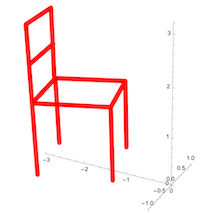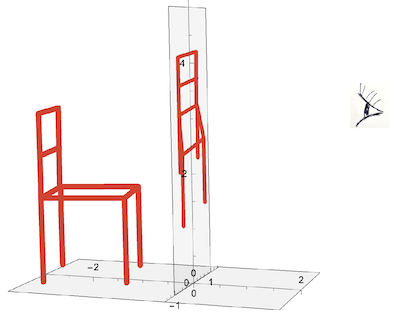 The above photos show 2D anamorphic images reflecting as 3D objects in a cylindrical mirror. In my previous community contribution, Anamorphosis of 3D-Objects & 3D Printing, I demonstrated the reflection of 3D anamorphic objects to get a realistic 3-dimensional reflection. Identical results can be achieved by reflecting 2D images. I will demonstrate this with two examples: a simple chair built from 132 line segments and a more complicated STL file of a human head consisting of 34,500 triangles obtained from the internet.
The above photos show 2D anamorphic images reflecting as 3D objects in a cylindrical mirror. In my previous community contribution, Anamorphosis of 3D-Objects & 3D Printing, I demonstrated the reflection of 3D anamorphic objects to get a realistic 3-dimensional reflection. Identical results can be achieved by reflecting 2D images. I will demonstrate this with two examples: a simple chair built from 132 line segments and a more complicated STL file of a human head consisting of 34,500 triangles obtained from the internet.
1. Chair
We start with a simple model of a chair to test our operating procedure. A chair can be constructed with line segments between a limited number of base points. But since the anamorphic image will transform lines into curves, we will need to interpolate a number of points between the base points.The following function will compute the 3D coordinates of m points evenly distributed between points ptA and ptB.
pointsInLine[{ptA : {xa_, ya_, za_}, ptB : {xb_, yb_, zb_}}, m_] :=
Transpose[{Subdivide[xa, xb, m], Subdivide[ya, yb, m],
Subdivide[za, zb, m]}]
Using the above function, we construct the 3 parts of the chair: seat, sides and back. Since we will later rotate the chair around its vertical axis, we introduce the angle phi as a variable.
seat[phi_] := (pointsInLine[#1, 10] &) /@
Partition[
RotationTransform[
phi, {0, 0, 1}, {-2, 0, 0}] /@ {{-2.77`, -0.77`, 1.61}, {-2.77`,
0.77`, 1.61}, {-1.23`, 0.77`, 1.61}, {-1.23`, -0.77`, 1.61}}, 2,
1, {1, 1}]
sides[phi_] :=
pointsInLine[#, 10] & /@
Map[RotationTransform[
phi, {0, 0, 1}, {-2, 0,
0}], {{{-2.77`, -0.77`, 0.07}, {-2.77`, -0.77`, 1.61}}, {{-2.77`,
0.77`, 0.07}, {-2.77`, 0.77`, 1.61}}, {{-1.23`, 0.77`,
0.07}, {-1.23`, 0.77`, 1.61}}, {{-1.23`, -0.77`,
0.07}, {-1.23`, -0.77`, 1.61}}}, {2}]
back[phi_] :=
pointsInLine[#, 10] & /@
Map[RotationTransform[
phi, {0, 0, 1}, {-2, 0,
0}], {{{-2.77`, -0.77`, 3.15`}, {-1.23`, -0.77`,
3.15`}}, {{-2.77`, -0.77`, 2.38`}, {-1.23`, -0.77`,
2.38`}}, {{-2.77`, -0.77`, 3.15`}, {-2.7`, -0.77`,
1.61`}}, {{-1.23`, -0.77`, 3.15`}, {-1.23`, -0.77`,
1.61`}}}, {2}]
chair[phi_] := Through[{seat, sides, back}[phi]]
This is the complete chair built from 132 line segments between 12 base points :
With[{phi = -1.25},
Graphics3D[{Red, AbsoluteThickness[8], Line /@ chair[phi]},
Boxed -> False, Axes -> True, AxesOrigin -> {0, 0, 0}]]

If we look at the chair, we see it as an "observed" 2D image in a plane perpendicular to our view direction. The following functions will convert the 3D chair point by point into a 2D image in the y-z plane if observed from a view point at (xv, 0, zv):
observedPoint[ptR : {xr_, yr_, zr_}, ptV : {xv_, 0, zv_}] :=
First[NSolveValues[{x, y, z} \[Element] InfiniteLine[{ptR, ptV}] &&
x == 0, {x, y, z}]]
observedChair[phi_] :=
Map[observedPoint[#1, {5, 0, 6}] &, chair[phi], {3}]
This code illustrates the relation between the real 3D chair and the observed 2D image:
With[{phi = -1.35},
Graphics3D[{{Opacity[.10],
InfinitePlane[{0, 0, 0}, {{0, 1, 0}, {1, 0, 0}}],
Polygon[{{0, -1, 0}, {0, -1, 5}, {0, 1, 5}, {0, 1, 0}}]}, {Red,
AbsoluteThickness[6], Line /@ chair[phi]}, {Red,
AbsoluteThickness[4], Map[Line, observedChair[phi], {2}]}},
Boxed -> False, Axes -> True, AxesOrigin -> {0, 0, 0}]]

The observed image can also be the reflection of an anamorphic 2D image in the x-y plane. To get the anamorphic image of the observed chair, we take the function explained and used here
anamorphPointCF =
Compile[{{ptP, _Real, 1}, {ptV, _Real, 1}},
Module[{yi, zi, xv, zv, t1, t2, t3},
{yi, zi} = ptP;
{xv, zv} = ptV; t1 = Sqrt[2 + 1/xv^2 + yi^2 - xv^2 (-1 + yi^2)];
t2 = 2 + yi^2 + 1/xv^2 + xv^2;
t3 = (1 + 2 xv^2 + yi^2 xv^2 + xv^4); {(-t1/xv + xv (t1 + yi^2))/
t2 - (-1 +
xv^2 (-1 + xv^2 +
xv^4 + (-1 - 2 xv^4 + xv^2 (3 + 2 t1)) yi^2)) (zi - (-1 +
1/xv^2 + t1 + yi^2) (-zv + zi)/t2)/(xv t3 (-zv + zi)),
yi (xv^2 (-1 + xv^2 - t1) t3 + (-1 - xv^2 (2 + 2 t1 + yi^2) +
xv^4 (-1 + 2 t1 + 2 yi^2)) (zv +
xv^2 zv (-1 + t1 + yi^2) + xv^2 (3 + xv^2 - t1) zi)/(zv -
zi))/t3^2, 0}], CompilationTarget -> "C"];
A point R is observed as point P in the y-z plane and is reflected as point A in the x-y plane. The anamorphic point A will be reflected in a cylindrical mirror as P if observed from the view point V at (xv, o, zv)

Applied to all 132 points of the chair, we get the chair's anamorphic image. When reflected in the cylindrical mirror, it will appear as the observed chair in the y-z plane.
anamorphChair[phi_] :=
Module[{xv = 5, zv = 6},
Map[anamorphPointCF[Rest@#, {xv, zv}] &, observedChair[phi], {3}]]
With[{phi = -1.25},
Graphics3D[{{Opacity[.15], Cylinder[{{0, 0, 0}, {0, 0, 5}}, 1],
InfinitePlane[{0, 0, -.001}, {{0, 1, 0}, {1, 0, 0}}]}, {Red,
AbsoluteThickness[4], Map[Line, anamorphChair[phi], {2}]}, {Red,
AbsoluteThickness[2], Map[Line, observedChair[phi], {2}]}},
Lighting -> "Neutral", Boxed -> False]]

For esthetic purposes, we fill the seat polygon. We can now make an animation of the reflected rotating chair:
Animate[Graphics3D[{{Opacity[.15],
Cylinder[{{0, 0, 0}, {0, 0, 5}}, 1],
InfinitePlane[{0, 0, -.001}, {{0, 1, 0}, {1, 0, 0}}],
Polygon[{{-.01, -1, 0}, {-.01, -1, 5}, {-.01, 1, 5}, {-.01, 1,
0}}]}, {Red, AbsoluteThickness[5],
Map[Line,
anamorphChair[phi], {2}], {FaceForm[Lighter[Red, .5]]}, {Red,
AbsoluteThickness[2.5], Map[Line, observedChair[phi], {2}]}}},
PlotRange -> {{-1, 14}, {-11, 11}, {-.01, 5}}, Boxed -> False,
ViewPoint -> {1, -2, .5}, ImageSize -> Large], {phi, 0,
2 \[Pi], \[Pi]/25}]

In order to demonstrate this reflected in a real mirror, we use what was previously demonstrated in Introducing Anamorphic Movies: we make a GIF of the rotating anamorphic chair.
iPadFrames =
Table[Module[{h = 6, x0 = -2, y0 = 0, z0 = 0, xv = 5, zv = 6,
sc = .5, chair, observedChair, anaChair, anaSeat, observedSeat},
ptV = {xv, 0, zv};
chair = Line[#[phi, sc, {x0, y0, z0}]] & /@ {seat, sides, back};
observedChair =
ParallelMap[observedPoint[#, {xv, 0, zv}] &, chair, {4}];
anaChair =
Map[anamorphPointCF[Rest@#, {xv, zv}] &, observedChair, {4}];
anaSeat = Polygon[Flatten[anaChair[[1, 1]], 1]];
observedSeat = Polygon[Flatten[observedChair[[1, 1]], 1]];
Graphics3D[{{Opacity[.15],
Polygon[{{0, -1, 0}, {0, -1, h}, {0, 1, h}, {0, 1, 0}}], ,
InfinitePlane[{0, 0, -.001}, {{0, 1, 0}, {1, 0, 0}}],
Cylinder[{{0, 0, 0}, {0, 0, h}}, 1]}, {AbsoluteThickness[8],
Red, anaChair}, {FaceForm[Lighter[Red, .5]], anaSeat}},
Axes -> {True, True, False}, AxesStyle -> Gray, Ticks -> None,
AxesOrigin -> {0, 0, 0}, Boxed -> False,
PlotRange -> {{-4, 17}, {-15, 15}, {-.001, 6}},
ImageSize -> Large, ViewPoint -> {0, 0, 10}]], {phi, 0,
2 \[Pi], \[Pi]/20}];
Export[NotebookDirectory[] <> "chair iPad.gif", iPadFrames,
AnimationRepetitions -> \[Infinity]];

We now upload the (attached)"chair iPad.gif" to an iPad and put a home made cylindrical mirror on top.

This is the result of the GIF's reflection:

2. Human head
We now move to a more complicated example using the same procedure as above. We import an STL file of a human head from: 3D Model Marketplace CGTrader:

headPolys =
Import["/Users/er/Downloads/male face 1.stl", "PolygonObjects"];
Length[headPolys[[1]]](*34496*)
Unlike the chair which is "see-through", the head is an opaque sphere and only part of it is visible from any viewpoint. We write a function that will delete the triangles that are invisible if observed from the eye position. Simplified: these are the triangles whose vertices are farther away from vie point V at (xv, 0, zv) than a certain distance d. This way, we extract the 25,600 visible triangles out of the the total amount of 34,496
Quiet[Module[{d = .05, scalingDivider = 20, x0 = -.5, z0 = 1.75,
xv = 10, zv = 5, rawScaledVertices, scaledVertices,
visibleVertices, observedVertices},
rawScaledVertices =
RotationTransform[Pi/2, {0, 0, 1}] /@
headPolys[[1]] /. {x_?NumericQ, y_, z_} -> {x, y, z}/
scalingDivider;
visibleVertices =
Length[
DeleteCases[
scaledVertices, _?(findInvisibles[#1, d] == True &)]];
observedVertices =
ParallelMap[observedPoint[#1, {xv, 0, zv}] &, visibleVertices, {2}];
Row[(Graphics3D[{FaceForm[LightGray],
EdgeForm[AbsoluteThickness[.1]], Triangle[#1]},
Boxed -> False, ViewPoint -> Front,
Lighting -> "Accent"] &) /@ {scaledVertices, visibleVertices,
observedVertices}]]]

Above left, we see the complete head with all triangles. In the middle is a side view of only the visible triangles. At right are the visible triangles as observed from the view point. We now compute the anamorphic map of the visible triangles:
Quiet@Module[{d = .12, scalingDivider = 22,(*offset*)x0 = -.5,
z0 = 1.75, xv = 10, zv = 5, rawScaledVertices, scaledVertices,
visibleVertices, observedVertices, anamorphVertices},
rawScaledVertices =
RotationTransform[.4, {0, 0, 1}] /@
headPolys[[1]] /. {x_?NumericQ, y_, z_} -> {x, y, z}/
scalingDivider;
scaledVertices =
DeleteCases[rawScaledVertices, _?(findInvisibles[#, d] &)];
visibleVertices =
DeleteCases[
scaledVertices, _?(polyCheck[#, {x0, 0, z0}, {xv, 0, zv}] ==
3 &(*all 3 vertices under view plane*))];
observedVertices =
ParallelMap[observedPoint[#, {xv, 0, zv}] &, visibleVertices, {2}];
anamorphVertices =
ParallelMap[anamorphPointCF[Rest@#, {xv, zv}] &,
observedVertices, {2}];
Graphics[{{FaceForm[Lighter[Gray, .5]],
EdgeForm[AbsoluteThickness[.1]],
Polygon[
anamorphVertices /. {x_?NumberQ, y_, z_} -> {x, y}]}, {Dashed,
Circle[]}}, PlotRange -> {{-5, 12}, {-10, 10}},
ImageSize -> 250]]

Reflected in the mirror, the anamorphic image is observed as the complete 3D head:

As we did with the chair, we animate the anamorphic image by varying the rotation angle around a vertical axis.
With[{d = .12, scalingDivider = 24,(*offset*)x0 = -.5, z0 = 1.75,
xv = 10, zv = 5},
headFrames =
Table[
Module[{rawScaledVertices, scaledVertices, visibleVertices,
observedVertices, anamorphVertices},
rawScaledVertices =
RotationTransform[phi, {0, 0, 1}] /@
headPolys[[1]] /. {x_?NumericQ, y_, z_} -> {x, y, z}/
scalingDivider;
scaledVertices =
DeleteCases[rawScaledVertices, _?(findInvisibles[#, d] &)];
visibleVertices =
DeleteCases[
scaledVertices, _?(polyCheck[#, {x0, 0, z0}, {xv, 0, zv}] ==
3 &(*all 3 vertices under view plane*))];
observedVertices =
ParallelMap[observedPoint[#, {xv, 0, zv}] &,
visibleVertices, {2}];
anamorphVertices =
ParallelMap[anamorphPointCF[Rest@#, {xv, zv}] &,
observedVertices, {2}];
Graphics[{{FaceForm[Lighter[Gray, .5]],
EdgeForm[AbsoluteThickness[.1]],
Polygon[
anamorphVertices /. {x_?NumberQ, y_, z_} -> {x,
y}]}, {Dashed, Circle[]}},
PlotRange -> {{-5, 12}, {-10, 10}}, ImageSize -> 600]], {phi, 0,
2 \[Pi] - \[Pi]/30, \[Pi]/30}]];
Export[NotebookDirectory[] <> "head iPad.gif", headFrames,
AnimationRepetitions -> \[Infinity]]

We load the GIF to an iPad and see its reflection in a cylindrical mirror. The reflection appears as a virtual image of a 3D rotating head inside the cylinder. I attached the two GIF files "chair iPad.GIF" and "head iPad.GIF". Load them to your iPad and see the magic! Have fun!

 Attachments:
Attachments: